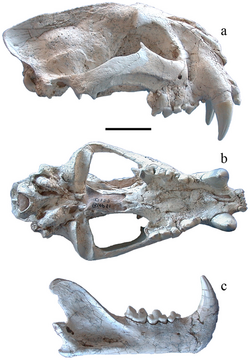Biology:Panthera zdanskyi
| Panthera zdanskyi | |
|---|---|

| |
| Holotype skull | |
| Scientific classification | |
| Domain: | Eukaryota |
| Kingdom: | Animalia |
| Phylum: | Chordata |
| Class: | Mammalia |
| Order: | Carnivora |
| Suborder: | Feliformia |
| Family: | Felidae |
| Subfamily: | Pantherinae |
| Genus: | Panthera |
| Species: | †P. zdanskyi
|
| Binomial name | |
| †Panthera zdanskyi Mazák, Christiansen & Kitchener, 2011
| |
| Synonyms | |
|
Uncia zdanskyi | |
Panthera zdanskyi is an extinct pantherine species, the fossils of which were excavated in Gansu Province, northwestern China. Due to its close relationship with the modern tiger (Panthera tigris), it is called the Longdan tiger.[1]
As of 2023, at least two recent studies considered P. zdanskyi likely to be a synonym of Panthera palaeosinensis, noting that its proposed differences from that species fell within the range of individual variation.[2][3]
Etymology
Panthera zdanskyi was first named by Ji H. Mazák, Per Christiansen and Andrew C. Kitchener in 2011. The specific name honors the Austrian paleontologist Otto A. Zdansky for his contributions to the understanding of Neogene China fossil carnivorans.[1]
Description
The holotype of Panthera zdanskyi consists of a nearly complete skull and mandible stored at the Babiarz Institute of Paleontological Studies. It is the oldest known complete pantherine skull ever found, and it indicates that the animal was about the size of a jaguar. The paratype comprises a rostrum, premaxilla and maxilla and much of the dentition, originally referred to Panthera palaeosinensis. It was collected in 2004 in the eastern slope of Longdan, south of Dongxiang Autonomous County in the Lower Pleistocene Equus layer, dating to the Gelasian stage of the earliest Pleistocene, about 2.55–2.16 million years ago.[1]
Phylogeny
The cladogram below follows Mazák, Christiansen and Kitchener (2011).[1]
| Pantherinae |
| ||||||||||||||||||||||||||||||||||||||||||||||||||||||
See also
References
- ↑ 1.0 1.1 1.2 1.3 Mazák, J. H.; Christiansen, P.; Kitchener, A. C. (2011). "Oldest Known Pantherine Skull and Evolution of the Tiger". PLOS One 6 (10): e25483. doi:10.1371/journal.pone.0025483. PMID 22016768. Bibcode: 2011PLoSO...625483M.
- ↑ Hemmer, Helmut (2023). "The evolution of the palaeopantherine cats, Palaeopanthera gen. nov. Blytheae (Tseng et al., 2014) and Palaeopanthera pamiri (Ozansoy, 1959) comb. Nov. (Mammalia, Carnivora, Felidae)". Palaeobiodiversity and Palaeoenvironments. doi:10.1007/s12549-023-00571-5.
- ↑ Jiangzuo, Qigao; Wang, Yuan; Ge, Junyi; Liu, Sizhao; Song, Yayun; Jin, Changzhu; Jiang, Hao; Liu, Jinyi (2023). "Discovery of jaguar from northeastern China middle Pleistocene reveals an intercontinental dispersal event". Historical Biology 35 (3): 293–302. doi:10.1080/08912963.2022.2034808.
External links
- Choi, C. Q. (2011). "World's Oldest Tiger Species Discovered". Live Science. https://www.livescience.com/17252-oldest-tiger-species-discovered.html.
Wikidata ☰ Q292596 entry
 |


